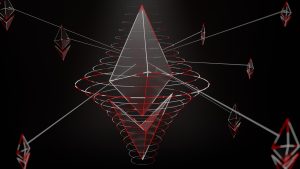I ended the first section of my previous memo (October 17, 2023) with:
“Bottom line, people were drawn to assets considered as ‘store of value’ in times of uncertainty. In other words, the ripple effect of the central bank raising interest rates following the dot com bubble was observed only years later in 2008. Is this the same growth we can expect from the BTC Spot ETF? Well, if the fake news going around on October 16, 2023, could be taken as a proxy, I have strong reasons to believe so.”
Fast forward a few months, 11 BTC ETF have been approved on January 11, 2024. After a bit more than a month, a total of $ 10 billion in assets have been invested. At the same time, $ 5 billion have been liquidated from the Grayscale’s Bitcoin Trust. So we could argue we have seen a $ 5 billion net inflow in just more than a month!
At first sight, one might think this is great news for the crypto space; institutional investors have an easy entry into the Bitcoin market. This is a big win for crypto. However, is it? Institutional investors are just people after all. So these shenanigans might just be them moving out of fear of missing out. What I ask myself if the following: what is the REAL impact of such players coming in the Bitcoin and larger crypto market?
Store of value, currency, or both?
Let us focus on Bitcoin for now. You are probably sick of hearing it, but we know (for now) there will only be 21 million Bitcoin available in the market. At least, for now (I will come back to this later). The current supply is 19,6 million Bitcoins. The last few million will be very tough to “mine”. So tough, it might take until 2140 to mine the last Bitcoins and reach 21 million in circulating supply!
To understand whether the latest Bitcoin ETF is indeed a positive or negative thing for the Bitcoin ecosystem, we need to establish what this ecosystem actually is and does.
The Bitcoin network was established as a form of decentralized digital payment infrastructure. Decentralized because there is no third-party watch dog acting as middle man. Digital because there is no physical counterpart of the Bitcoin tokens. They only exist within the digital infrastructure created. The technical infrastructure consists of “miners”. Miners are computers, owned by companies and individuals alike (although now less and less miners are run by individuals), who approve Bitcoin transactions. Each individual module within the miners being able to approve a transaction is called “node”. The miners are the ones who implement the network protocol, maintain it, and could change it with the majority of the votes in the network.
The entire infrastructure is designed such that for each block of transactions approved by the miners, a new Bitcoin will be issued in the network and assigned to the miner of to the set of nodes used to approve the transaction. The more transactions, the more incentives for the miners. This will continue until all 21 million Bitcoins are issued. After that, miners will have to “pay the bills” with transaction fees only.
Name of the game: volume. The more people use Bitcoin as a means of payment, the better for the infrastructure. Obviously just like fiat currency, people spend it, save it, invest it. The same applies to Bitcoin. But this is fundamentally different that using it as store of value.
Now we get to the interesting part. Using Bitcoin as a store of value implies there are no transactions. And with no transactions, the network comes to a standstill.
The other side of the (Bit)coin
To illustrate this dynamic, I will take you along a little thought experiment.
Imagine we are at a big sport event in a stadium, together with 500.000 people. When we walk in, we are asked to purchase stadium tokens, physical tokens that is. They go for $1 a token. And we can use them to pay for beer, food, merch, etc within the stadium. Assuming an average spend of 100 tokens per person, the stadium printed 50 million tokens. For consistency, let’s also imagine this was the first ever event organized in this stadium and that the tokens can be reused for future events as well.
Tokens start to circulate around the stadium. There’s groups of people drinking before the game. Others buying merch from their favorite teams. The currency is circulating. Stores are earning. You know the drill.
At one point, news spread that next year the tokens will be sold at $1,50 per token. That is a 50% gain compared to the current price of tokens.
A first group of people starts accumulating tokens. They start telling their friends who also start doing the same thing. What happens in the rest of the stadium? Well, there is less available for people to use. Less available for bars, restaurants, and shops to earn. But also less available for them to continue existing.
The more people hoard, the less beneficial for the ecosystem.
With those tokens not circulating, there is no reason for the entire ecosystem within the stadium to exist. And as a consequence, the value of the tokens is also undermined. After the ETF issuance, 70% of all the Bitcoins sold in the market is inactive. So about 14 million Bitcoins sits in a wallet. Not being used for what it is: a digital currency. But being held in expectation of future value appreciation.
The only inconsistency is: the value appreciates if the network is active and thriving. Not when the network hoards while putting at risk the entire infrastructure.
Can it be both?
The honest answer is: it might. But we need to change how we look at Bitcoin. And we need to let go of a new assumptions we are holding tight to.
If we all agree that the Bitcoin token is like a share of the Bitcoin network, in other words, by buying the Bitcoin token we are owning a piece of the network, then it can be considered as a store of value. In this the case, the currency will have to come from an additional token issued from within the infrastructure: some sort of Bitcoin cash token (not to be confused by the actual Bitcoin Cash token BCH!).
But if this is true, Bitcoin does not necessarily have to be limited to 21 million. Why? Because we as owners of the network, can decide so. If the largest Bitcoin owners join force, assemble, and, with the majority of the votes, decide to increase the supply: then the protocol can be overwritten and updated.
What would this scenario mean for us? Both as owners and users of Bitcoin.
For the owners, it literally makes no difference. Should the network need investments, for which it makes sense to attract more capital, then it might make sense to increase the supply. Investments in this context should not be confused with the traditional way to raise capital and invest it in a company. In this case, if the Bitcoin’s owners decide to issue more Bitcoins, this means the miners (owners and participants of the network) can receive Bitcoins by means of mining rewards and therefore attract capital for additional investments in the infrastructure.
Current owners would dilute relative to the amount of newly issued Bitcoins, but the network will have more capital to use for to renew its infrastructure, etc. Owners would keep earning a piece of the network’s earning in terms of transactions fees or staking fees, if that becomes available on Bitcoin as well.
For the users, it is still a major win because none of this we discussed so far changes the fact that they have a world-wide, instant, decentralized, payment infrastructure at their disposal. It works 24/7, at ridiculously low fees, and with full transparency.
Newsletter
Stay up-to-date with the latest developments in the stock and crypto market., fund, and crypto market.
Disclosure
These are unqualified opinions, and this newsletter, is meant for informational purposes only. It is not meant to serve as investment advice. Please consult with your investment, tax, or legal advisor, and do your own research.




No comment yet, add your voice below!